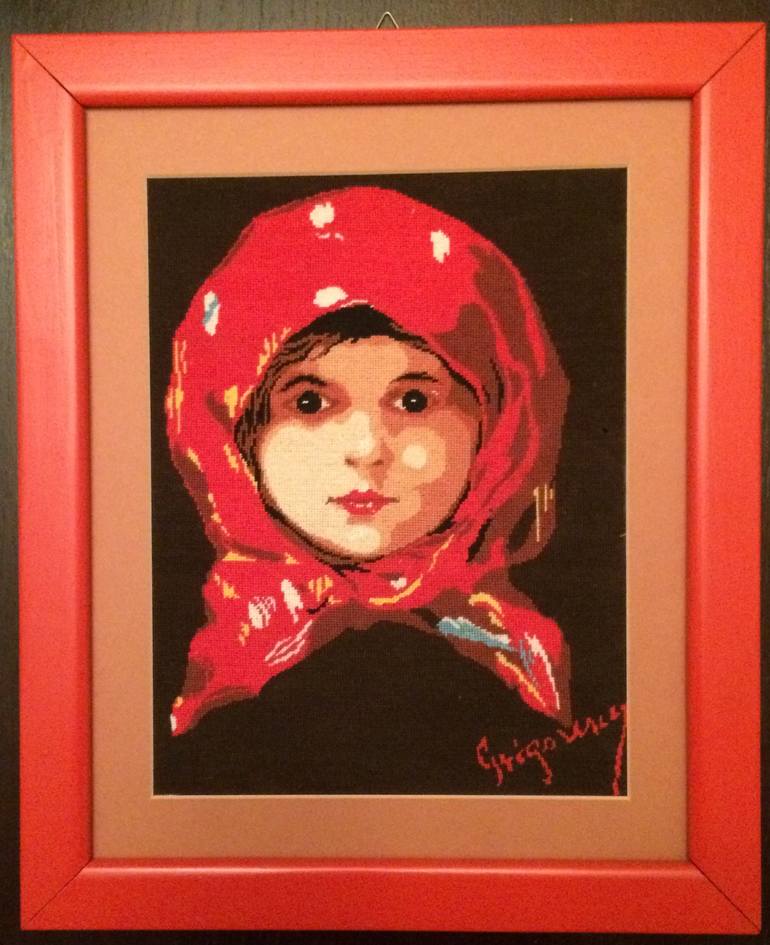


VIEW IN MY ROOM
The little girl with red kerchief Collage
Romania
Collage, Fabric on Soft (Yarn, Cotton, Fabric)
Size: 10.8 W x 14.2 H x 0.7 D in
Ships in a Box
About The Artwork
"The little girl with red kerchief" is a reproduction of the famous roumanian painting, Nicolae Grigorescu. It's an arras made on painted canvas with colored thread. The tapetery has 11 colours and a red frame.
Details & Dimensions
Collage:Fabric on Soft (Yarn, Cotton, Fabric)
Original:One-of-a-kind Artwork
Size:10.8 W x 14.2 H x 0.7 D in
Frame:Other
Ready to Hang:Not applicable
Packaging:Ships in a Box
Shipping & Returns
Delivery Time:Typically 5-7 business days for domestic shipments, 10-14 business days for international shipments.
Handling:Ships in a box. Artists are responsible for packaging and adhering to Saatchi Art’s packaging guidelines.
Ships From:Romania.
Customs:Shipments from Romania may experience delays due to country's regulations for exporting valuable artworks.
Have additional questions?
Please visit our help section or contact us.
Romania
Tapestry is a decorative textures of wool or silk, hand crafted used especially as decoration on house walls or furniture. In other words, tapestry is a textile surface built with a decorative purpose and utilitarian functions. Compared with upholstery, which is a simple textile work, with purpose of covering furniture pieces, tapestry is a work of art. Tapestry is well know from Antiquity mostly represented by Chinese silk texture (T’ang dynasty textures, Egypt and antic Greek textures comes as a prove). Tapestry flourished in civilizations greatest moments, through out the years and they reflected civilization’s aesthetics inclinations. In the Middle Ages, tapestry had a purely utilitarian function. Tapestries were originally designed to protect medieval rooms from damp and cold weather or to cover austere walls of big castles or to insulate big rooms in more comfortable quarters. In these early tapestries, isolated figures or compact groups stood out against a background that was generally plain or embellished with plants motifs or flowers, those are called « mille fleurs » Tapestry became beside painting, sculpture and architectures one of the major visual art forms. . By 1500, Flanders, especially Brussels and Bruges, had become the chief places of production. In 1663, during the lavish reign of Louis XIV, Les Gobelins factory was founded in Paris employing over 800 artisans in the production of tapestries for the royal court. Other European countries followed, opening factories on behalf of their rulers. Starting with the second half of last century, new tapestry is evolving called “goblen”. Goblen tapestry thematic is practically unlimited and can vary on dimensions, technical ability and tapestry final destination. Each new product is in fact unique and brings to life a small part of it’s creator fantasy. Once available only for its manufacturer, now they are available for everyone.
Thousands Of Five-Star Reviews
We deliver world-class customer service to all of our art buyers.
Global Selection
Explore an unparalleled artwork selection by artists from around the world.
Satisfaction Guaranteed
Our 14-day satisfaction guarantee allows you to buy with confidence.
Support An Artist With Every Purchase
We pay our artists more on every sale than other galleries.
Need More Help?